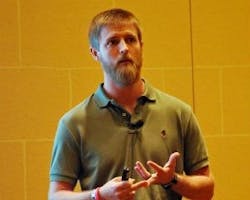“A project to add wired vibration transmitters took two years. With wireless, the PO would take longer than the install.” BP’s Jack Ellison summarized progress on a wireless networking pilot due to go live in July on the company’s Atlantis platform in the Gulf of Mexico.
“’Modernization’ and ‘transformation’ are buzzwords, but they’re also opportunities,” said Jack Ellison, control and automation engineer, BP. “Today, all our instruments are wired and our diagnostics are stranded. Technicians can access them with a Fluke [handheld], but unless it’s already a problem, they never get back to the engineers. We have robust valve diagnostics, but failures we could have foreseen end up causing lost production.”
Ellison works in BP’s Houston office, which serves multiple platforms in the Gulf of Mexico, and is in the midst of installing wireless on the company’s Atlantis platform, which has a nameplate capacity of 200,000 bbl/day, a 161,000 sq.ft. main deck, and seven decks in all. He described the project’s motivation, method and progress at Honeywell Users Group Americas 2018 this week in San Antonio.
“We have other equipment—heat exchangers, pumps, etc.—where we would like to add vibration, temperature and additional pressure information if we had wireless,” Ellison said. The platform’s maintenance group has replaced paper rounds with tablets. “They download the rounds in the office, do the round, then synchronize,” he said. “They wanted us to do wireless.”
Without wireless communications, when you need a wiring diagram or a data sheet, you have to walk back to the office and bring it up on a computer. “During troubleshooting, the technician is our eyes on the platform, and we communicate by e-mail,” Ellison said. “We might get a picture or two, and if we’re lucky, it might show what we need to see. Something that would take minutes by video can take hours or days by e-mail.” He would also like to streamline calibrations and loop checks, which now take multiple people communicating by radio.
“A project to add wired vibration transmitters took two years. With wireless, the PO would take longer than the install,” Ellison said. “With wireless tablets, we could have digital procedures, collaboration and live video for troubleshooting.”
It takes more than hardware
“With any new project, there’s some hesitancy,” Ellison said. “On a platform, there’s a perception that wireless won’t work.” To prove it would, they scoped and designed a pilot that covers just the production deck, where most of the process equipment is located, with integrated WiFi, WirelessHART and ISA 100 networks. The system is designed to pull diagnostics into the asset management system, provide mobile HMI on intrinsically safe tablets, allow new wireless instruments to be deployed quickly at lower cost, and support live video for walkdowns and troubleshooting.
“The wireless instrument network supports both HART and ISA 100 with the same access points,” Ellison said. “Most of our instruments are HART, but the Bently Nevada vibration system is ISA 100, and we expect much of the additional instrumentation will be ISA 100.”
The project called for more than technical expertise—it also had to be sold. “Management, engineering and offshore each have different concerns and need a different pitch,” Ellison said. “Management is looking for ROI, engineering wants to know, ‘Will this even work?’ Everybody has security concerns, and you need to be ready to address them. You need to know how you will integrate with the distributed control system and asset management systems, and to decide who owns the wireless. Will IT own it? For us, everything below the offshore firewall—the DMZ and lower—is owned by operations. That simplifies maintenance and lifecycle management.”
Start small, and don’t overpromise the initial use cases. Do just control valve diagnostics or digital field instruments, and build on that. “Find valves or instrumentation with a history of a problem, and make sure they’re covered in the pilot,” Ellison said.
When rolling out the project, cater your presentation to the audience. “We had a big meeting with everyone in the room having different concerns and using different jargon,” Ellison said. “It went on for an hour, and we didn’t get a lot done.” Instead, hold a series of smaller meetings and be the middleman translating the jargon from one group to another.
Finally, have a definition of success, and a plan to communicate it when it happens.
Current status and plans
The Atlantis pilot project is almost ready. “We expect to go live in late July,” Ellison said. “We have strong buy-in, and our digital security test was a success. We’re working with IT for Skype support, testing with ValveLink software, and testing the mobile HMI software.”
After a successful pilot, the plan is to install full platform wireless (estimated to require 20 access points). Ellison wants to add vibration and corrosion monitoring, as well as wireless personal gas detectors. “That will allow personnel tracking, but that’s controversial,” Ellison said. “We also want to add materials management, which will help us find the things we need to do our projects. And we’re looking at CCTV so we can see the process in an emergency.
“Beyond that, who knows? We can’t tell what new applications will be available in the future. We do know that we see value now, and expect it to be greater a year from now.”
About the Author
Paul Studebaker
Paul Studebaker

Leaders relevant to this article:


